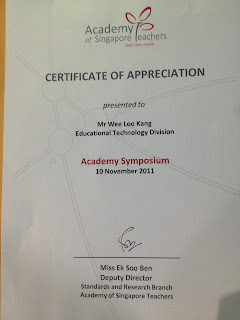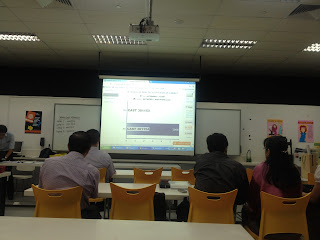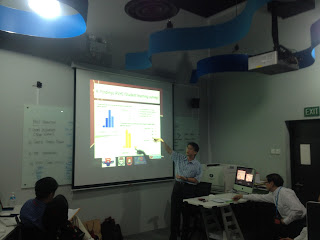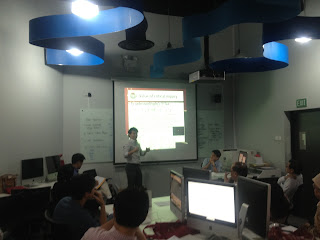http://weelookang.blogspot.sg/2011/06/academy-symposium-10th-november-2011-to.html
Briefing Document: Open Educational Resources / Open Source Physics @ Singapore
1. Overview
This document summarizes the key themes and ideas presented in the provided source, which focuses on the use of Open Educational Resources (OER) and Open Source Physics (OSP) in Singapore's education system, particularly in physics education. The main emphasis is on leveraging simulations and technology to create student-centered, inquiry-based learning environments. The source materials primarily revolve around a presentation given at the Academy Symposium on November 10, 2011, by Wee Loo Kang, Lee Tat Leong, and Goh Giam Hwee.
2. Main Themes
- Integration of ICT in Physics Education: The core theme is the meaningful integration of Information and Communication Technology (ICT) in physics education to enhance student learning. This involves moving beyond traditional teaching methods to incorporate interactive simulations and digital resources.
- "The third Masterplan for ICT (MOE, 2009b) technology design for learning initiative using free tools from the Open Source Physics (Christian, 2010) seeks to illustrate meaningful integration of ICT in physics education through student centred activities..."
- Open Source Resources: The project heavily relies on free tools from the Open Source Physics community, particularly Easy Java Simulation (EJS). This allows for the customization of simulations to align with the Singapore syllabus and learning objectives.
- "The Open Source Physics community which uses Easy Java Simulation (Esquembre, 2004) has created hundreds of simulations that can be customized (Wee & Mak, 2009) to the Singapore syllabus for productive learning experiences."
- Student-Centered Learning: The approach emphasizes student-centered activities, promoting self-directed learning and social collaborative learning. Students are encouraged to explore and construct their understanding through inquiry-based methods.
- "technology design for promoting self-directed learning... in students, the use of free tools from the Open Source Physics (Christian, 2010) should be harnessed."
- Guided Inquiry: The learning process is supported by a guided inquiry approach. This involves students using simulations to explore phenomena, guided by teachers' questions and prompts, leading them to deeper conceptual understanding.
- "these customised simulations supported by social collaborative discourses, will provide learning experiences to deepen student’s conceptual understanding of Physics through student-centred guided inquiry (Kirschner, Sweller, & Clark, 2006) approach."
- Social Collaborative Discourse: Social interaction and discussion among students are considered essential for learning, further enriching their understanding of concepts.
- "supported by effective processes of collaborative learning (Chai, Lim, So, & Cheah, 2011) is a meaningful step forward for engaged learning."
- Customizable Simulations: The use of EJS allows for the creation of simulations tailored to the Singapore syllabus, making them more relevant to students' learning experiences. The use of Easy Java Simulation (Esquembre, 2004) has created hundreds of simulations that could be finer customized (Wee & Mak, 2009) to the Singapore syllabus for more targeted productive activities.
- Teacher Professional Development: The future direction includes subject chapter physics teachers leading simulation-based curriculum development, advancing the professionalism of educators.
- "Subject chapter physics teachers lead simulation based curriculum, advancing the professionalism of educators (MOE, 2009a)."
3. Key Ideas and Facts
- Academy Symposium Presentation: The core of this document revolves around a presentation at the Academy Symposium on November 10, 2011, by Wee Loo Kang, Lee Tat Leong, and Goh Giam Hwee. The presentation focused on their work integrating simulations and student-centered learning in Physics education.
- Specific Simulations Shared: The presenters shared the following simulations:
- Collision cart simulation (designed by RVHS - River Valley High School).
- Five gravitational simulations (developed for Yishun JC - Yishun Junior College).
- These are considered appropriate laboratory environments that can deepen students’ conceptual understanding.
- Cognitive Load Theory and Social Constructivism: The underlying theoretical frameworks are Cognitive Load Theory and Social Constructivism, which suggest that learning is most effective when cognitive load is managed effectively and when students construct knowledge through social interaction and experience.
- "Cognitive Load Theory & Social ConstructivismImplications: Student-centred active learning through customized simulations with guided inquiry and social discourse can enhance learning of physics concepts."
- Video Recording: The presentation was filmed to encourage the proliferation of the Open Source Physics network. The edited videos were shared online.
- "Our session has taken the liberty to film(video) ourselves to encourage the proliferation of our Open Source Physics network, lead by myself (Wee Loo Kang), Lee Tat Leong and Goh Giam Hwee."
- References: The document cites several research articles and official documents to support the approach, including works by Kirschner, Sweller, and Clark on the effectiveness of minimal guidance instruction, as well as publications related to Singapore's MOE's ICT masterplans and self-directed learning initiatives.
- Creative Commons Licensing: The works are licensed under Creative Commons Attribution, encouraging sharing and adaptation of the resources. "Our works are licensed under creative commons attribution http://creativecommons.org/licenses/by/3.0/"
- Various Workshops and Presentations: The document mentions numerous other workshops and presentations given on the same topics at various schools and conferences, indicating widespread interest and adoption of these methods.
- Additional Resources: The document contains links to a large number of simulations and tools that were developed based on the described methodology. These resources cover a broad range of topics and subjects.
4. Implications
- Enhanced Learning: The use of simulations and guided inquiry can lead to a deeper and more meaningful understanding of physics concepts.
- Student Engagement: Student-centered activities and collaborative learning foster greater engagement and motivation.
- Adaptable Resources: OER and OSP offer adaptable resources that can be tailored to specific contexts and learning needs.
- Teacher Empowerment: Teachers are empowered to create customized learning experiences for their students, further developing their skills as educators.
- Widespread Adoption: The presentation and associated resources are aimed at encouraging wider adoption of these practices in the Singapore education system.
5. Conclusion
This source highlights a significant effort in Singapore to integrate technology into physics education through open-source resources and student-centered learning approaches. The emphasis on customization, guided inquiry, and collaborative discourse aims to enhance student understanding and engagement. The project also highlights the important role of teacher professional development in effectively implementing these strategies. The availability of open resources licensed under creative commons, as well as other simulations created by the team over the years, makes the approach easily scalable and adaptable for use in other learning environments.
The Academy Symposium 10th November 2011 Science Centre
The Academy Symposium
10th November 2011 to be hosted by the Academy of Singapore Teachers,
2 Malan Rd S(109433)
15 Science Centre Road
Singapore 609081
Submission of Synopsis for Concurrent Sessions
Objectives of the Concurrent Session:
This session will comprise two parts: sharing on effective teaching practices or a school-based action research followed by co-generative dialogue with the participants for further professional learning. Please note that presenters need to facilitate the dialogue.The deadline for submission is 25th July 2011, MonTitle for my sharing:
Physics by Inquiry with Simulations Design for Learning draft PPT https://docs.google.com/present/edit?id=0ATIvSg-TzZrZZGZmN3dnYzdfNzQ3Z2JtdzdtZjg&hl=en_US
final: https://docs.google.com/open?id=0BzIvSg-TzZrZMTU2NzI1OTctNDJhNi00YjllLThmZmItMjVjYTkyOTMzZTg4
The simulations (NTNU Java virtual Lab) and curriculum materials (ICT connection lesson) can be found.
All 4 parts in one video thanks to YouTube for giving me longer than 15 minutes!
Video is up. part 1/4
part 2/4
part 3/4
part 4/4
The Write-Up.
Rationale:
The third Masterplan for ICT (MOE, 2009b) technology design for learning initiative using free tools from the Open Source Physics (Christian, 2010) seeks to illustrate meaningful integration of ICT in physics education through student centred activities, for promoting self-directed learning (Tan, Shanti, Tan, & Cheah, 2011) supported by effective processes for social collaborative learning (Chai, Lim, So, & Cheah, 2011).
Background:
The Open Source Physics community used Easy Java Simulation (Esquembre, 2004) has created hundreds of simulations that could be finer customized (Wee & Mak, 2009) to the Singapore syllabus for more targeted productive activities.
We will share the collision cart simulation with RVHS (Lee, Wee, Cheng, & Wong, 2010) and 5 gravitational simulations with Yishun JC. These simulations we argue are appropriate laboratory environments that can provide the experience and context essential for deepening student’s conceptual understanding of Physics through student centred guided inquiry (Kirschner, Sweller, & Clark, 2006) approach supported by social collaborative discourse. Theory:
Cognitive Load Theory & Social ConstructivismImplications:
Student-centred active learning through customized simulations with guided inquiry and social discourse can enhance learning of physics concepts.Future Direction:
Subject chapter physics teachers lead simulation based curriculum, advancing the professionalism of educators (MOE, 2009a). Reference:
- Reference:
- Chai, C. S., Lim, W.-Y., So, H.-J., & Cheah, H. M. (2011). Advancing collaborative learning with ICT: Conception, Cases and Design. MOE (Ed.) Retrieved from http://ictconnection.edumall.sg/ictconnection/slot/u200/mp3/monographs/advancing%20collaborative%20learning%20with%20ict.pdf
- Christian, W. (2010). Open Source Physics (OSP) Retrieved 25 August, 2010, from http://www.compadre.org/osp/
- Esquembre, F. (2004). Easy Java Simulations: A software tool to create scientific simulations in Java. Computer Physics Communications, 156(2), 199-204.
- Kirschner, P. A., Sweller, J., & Clark, R. E. (2006). Why Minimal Guidance during Instruction Does Not Work: An Analysis of the Failure of Constructivist, Discovery, Problem-Based, Experiential, and Inquiry-Based Teaching. Educational Psychologist, 41(2), 75-86.
- Lee, T. L., Wee, L. K., Cheng, S. S. S., & Wong, J. P. (2010). Virtual Experiential Learning Laboratory with Ejs Java Applet Collision Carts Retrieved 02 June, 2010, from http://ictconnection.edumall.sg/cos/o.x?ptid=711&c=/ictconnection/ictlib&func=view&rid=18
- MOE. (2009a). Teachers — The Heart of Quality Education Retrieved 20 October, 2010, fromhttp://www.moe.gov.sg/media/press/2009/09/teachers-the-heart-of-quality.php
- MOE. (2009b). Third Masterplan for ICT in Education Retrieved 20 October, 2010, from http://ictconnection.edumall.sg/cos/o.x?c=/ictconnection/pagetree&func=view&rid=665
- Tan, S. C., Shanti, D., Tan, L., & Cheah, H. M. (2011). Self-directed learning with ICT: Theory, Practice and Assessment. MOE (Ed.) Retrieved from http://ictconnection.edumall.sg/ictconnection/slot/u200/mp3/monographs/self-directed%20learning%20with%20ict.pdf
- Wee, L. K., & Mak, W. K. (2009, 02 June). Leveraging on Easy Java Simulation tool and open source computer simulation library to create interactive digital media for mass customization of high school physics curriculum. Paper presented at the 3rd Redesigning Pedagogy International Conference, Singapore.
Update: 29/09/2011
found my own abstract here. seems edited by AST http://www.academyofsingaporeteachers.moe.gov.sg/cos/o.x?c=/ast/pagetree&func=view&rid=1073201#k
1.10 Physics by Inquiry with Simulations Design for LearningSecondary PhysicsMr Wee Loo Kang (Educational Technology Division)Mr Lee Tat Leong (River Valley High)Mr Goh Giam Hwee (Yishun JC)In light of the third Masterplan for ICT (MOE, 2009), technology design for promoting self-directed learning (Tan, Shanti, Tan, & Cheah, 2011), in students, the use of free tools from the Open Source Physics (Christian, 2010) should be harnessed. The Open Source Physics community which uses Easy Java Simulation (Esquembre, 2004) has created hundreds of simulations that can be customized (Wee & Mak, 2009) to the Singapore syllabus for productive learning experiences. The integration of these ICT tools in Physics education through student-centred activities and supported by effective processes of collaborative learning (Chai, Lim, So, & Cheah, 2011) is a meaningful step forward for engaged learning.In this session, the team will share the collision cart simulation designed by RVHS (Lee, Wee, Cheng, & Wong, 2010) and 5 gravitational simulations. It is the team’s belief that these customised simulations supported by social collaborative discourses, will provide learning experiences to deepen student’s conceptual understanding of Physics through student-centred guided inquiry (Kirschner, Sweller, & Clark, 2006) approach.
|
Concurrent Session /
Venue
|
Title of presentation
|
Presenter
|
Co-presenter(s)
|
Facilitator
|
Level /Subject
|
|
1.10
Movie Lab
(Level 1)
|
Physics by Inquiry with Simulations Design for Learning
|
Mr Wee Loo Kang
Educational Technology Division
|
Mr Lee Tat Leong
River Valley High School
Mr Goh Giam Hwee
Yishun Junior College
|
Charles Chew
Yap Boon Chien |
Secondary Physics
|
Time: 1100-1200
Venue: Science Centre, Movie Studio Level 1
Update:20/09/2011
Dear 1st presentersTo add value to the learning experience of both the presenters as well as the participants so that it is a meaningful and fruitful session for all, we have arranged for the following:
Briefing @ AST
Please attend the briefing by MTTs, details of which are as follows:
Date: 6 October (Thursday) or 11 October (Tuesday). Please indicate your preferred slot in the form attached.
Time: 3pm
Venue: Academy of Singapore Teachers
TR 16 & 17Dry Run @ Science Centre Singapore
We have arranged for presenters to familiarise with the presentation venues and set up.
Details are as follows:
Date: 8 November (Tuesday)
Time: 2.15pm or 3.15pm or 4.15pm. Please indicate your preferred slot in the form attached.
Venue: Visitors' Centre @Science Centre Singapore
 |
| from http://www.academyofsingaporeteachers.moe.gov.sg/cos/o.x?c=/ast/pagetree&func=view&rid=1073129 |
Dear Teachers,The Academy of Singapore Teachers is pleased to invite you to register for the inaugural Academy Symposium Celebrating Learning, Transforming Practice.The Symposium aims to bring teachers together to celebrate their continual engagement in professional networked learning. It is also an affirmation of teachers taking ownership for and leadership of their professional growth with the aim of transforming their practice. The objectives of the Symposium are to:
a) provide a platform for the fraternity to celebrate the collaborative efforts in professional networked learning; and
b) nurture a vibrant culture of teacher-led professional learning to inspire and transform practice.Details of the Symposium are as follows:
Date: 10 November 2011 (Thursday)
Time: 0800h – 1730h
Venue: Science Centre Singapore
15 Science Centre Road
Singapore 609081Please visit the Academy Symposium website for more details. Registration is extended till 10 October 2011. The registration form is attached. You can also download the registration form at the Symposium website. Please complete the registration form and email it to by 10 October 2011Update 4:
Other Sessions of interest to me.
2.7b Use of Video-based Instruction to Visualise Inquiry Demonstration (VIVID) to Enhance Understanding of Light & Waves for Upper SecondarySecondary PhysicsMr Chan Yook Mun (Hong Kah Sec)Mrs Julie Quah (Bukit Batok Sec)Mr Quek Chin Keong (Bukit Batok Sec)Mr Tan Chong Chay (Hong Kah Sec)The 21st century learners are digitally literate. They use sound and images to convey content whenever possible, enjoy multi-tasking and have shorter attention spans. To engage and to prepare these learners to be self-directed in their learning, teachers need to use more learner-centred strategies.Project VIVID, a video-based novel approach transforms the teacher-centric traditional demonstration to pupil-centric inquiry demonstration. Customised video clips are used to capture students’ attention. By means of Socratic questioning together with a guided worksheet, engaging and effective inquiry-based lessons in Light and Waves for Upper Secondary Physics are designed for teachers’ use.In Hong Kah Secondary School, these videos are loaded onto the school’s Facebook and pupils in the school are encouraged to capitalise on social media in their learning. In Bukit Batok Secondary School, the teachers use demonstration to trigger a discussion. The videos are captured for student recall and review in the following lessons. These videos are content specific, and are critical for students to use for problem solving. The use of video-based instruction to visualise inquiry demonstrations is in line with John Gilbert’s three levels of visualisation of macro, micro and symbolic representation for effective teaching and meaningful learning.
3.7 Use of Video-based Instruction to Visualise Inquiry Demonstration (VIVID) to Enhance Understanding of Physics Concepts in Lower Secondary ScienceSecondary PhysicsMrs Yeo Swee Leng (Bedok Town Sec)Mr Lim Jing Kai (Bedok Town Sec)The project aims to redesign inquiry-based learning in Science and enhance understanding of Physics concepts in Lower Secondary Science such as Parallel and Series Circuits through videos created by teachers. Students are engaged in active discussions based on specially developed videos instead of just reading through the experimental procedure and carrying out the task.The project is based on the Dual Coding Theory which argues that memory is facilitated when two processes such as visual and verbal learning are engaged (Tan et. al., 2003). With the self-created videos that are customised according to syllabus outcomes, teachers then applied the 5E (Engage, Explore, Explain, Elaborate and Evaluate) pedagogical framework to inspire teaching and engaged learning. The video creations also allow teachers to work collaboratively in the design and development of inquiry lesson activities and thereby building teacher capacity and fostering greater collegiality.Based on the generative conversations on this VIVID project at this session, an Action Research project will be carried out to determine the impact of VIVID on students’ learning in both cognitive and affective domains.
Update 29/09/2011
| ACADEMY SYMPOSIUM | ||||||||||||||||||||||||||
| PRESENTERS INFORMATION | ||||||||||||||||||||||||||
| Concurrent Session Number |
Presenter(s) Details Please indicate 1st presenter with * |
Briefing Session# 6 Oct or 11 Oct |
Dry Run 8 Nov |
Vegetarian dietary request |
||||||||||||||||||||||
| Name | School/Division | |||||||||||||||||||||||||
| 1.10 | WEE Loo Kang | Education Technology Divis | This email address is being protected from spambots. You need JavaScript enabled to view it. | Yes. 11 Oct | Yes. 3.15pm | No | ||||||||||||||||||||
| 1.10 | LEE Tat Leong | River Valley High | Yes. 11 Oct | Yes. 3.15pm | No | |||||||||||||||||||||
| 1.10 | GOH Giam Hwee Jimmy | Yishun Junior College | Yes. 11 Oct | Yes. 3.15pm | No | |||||||||||||||||||||
Programme for 11 Oct 2011
2.30 pm Registration
3.00 pm Objectives of Symposium ,Programme, Networked Learning
3.30 pm Enacting Networked Learning, 6th Oct – Pri Science team, 11th Oct – Soc Studies team
4.15 pm Tea break
4.30 pm Meeting up with Subject Chapter MTTs to discuss presentation of networked learning
5.00 pm Dissemination of administrative information
5.15 pm Q & A
1. Where can I park at the Academy of Singapore Teachers?
At the Academy, we have around 60 Car Park places available on a 1st-come-1st-served basis for participants/visitors. Once all the parking places have been taken, participants/visitors may wish to park at the nearby Car parks at the various buildings around the Academy.
The location of buildings along with the parking charges are appended in Appendix 8a to 8d. Parking charges range between S\(1.20 and S\)1.61 per hour (Mon-Fri before 5/6pm).
NOL Building 456 Alexandra Road, S(119962) ?
Hort Park?
PSA Building 460 Alexandra Road, S(119963)
The Comtech 60 Alexandra Terrace, S(118502)
Update 17 October 2011
|
Date:
|
10 November 2011 (Thursday)
|
|
Time:
|
8.00am – 5.30pm
|
|
Venue:
|
Science Centre Singapore
15 Science Centre Road
Singapore 609081 |
|
0800
|
|
|
0900
|
Arrival of Guest of Honour
Opening Address by
Academy of Singapore Teachers
|
|
0925
|
|
|
1030
|
Tea Break
|
|
1100
|
|
|
1200
|
Lunch
|
|
1300
|
Plenary Session 2
|
|
1400
|
Plenary Session 3 / Concurrent Session 2
|
|
1500
|
Plenary Session 4 / Concurrent Session 3
|
|
1600
|
Tea Break
|
|
1620
|
Plenary Session 5
|
|
1720
|
Closing Remarks
|
test
 |
| Letter of Appreciation from Academy of Singapore Teachers |
FAQ on Open Source Physics Simulations in Education
- What is Open Source Physics (OSP) and how does it relate to education?
- Open Source Physics (OSP) is a community-driven initiative that develops free, customizable, and interactive physics simulations and resources. These resources, often created using tools like Easy Java Simulations (Ejs), are designed to enhance physics education by providing visual and hands-on learning experiences. They allow for deeper understanding of concepts through student-centered activities and simulations tailored to specific educational needs.
- How are OSP simulations being used in the Singapore education system?
- In Singapore, OSP simulations are being integrated into the physics curriculum to promote self-directed learning, active inquiry, and social collaborative learning. Teachers are using customized simulations, such as those focusing on collision carts or gravitational fields, to create engaging laboratory environments that enhance students' conceptual understanding. These simulations are aligned with the Singaporean syllabus and enable more targeted and productive learning activities. The focus is on moving away from traditional teacher-centric methods to embrace technology design for learning.
- What are some specific examples of OSP simulations used in the classroom?
- Several specific examples of OSP simulations used in classrooms include simulations for:
- Collision carts, which demonstrate principles of momentum and energy.
- Gravitational fields, including those of two masses, the Earth and Moon, geostationary satellites, and Kepler's Third Law.
- Radioactive decay, with two-state and three-state models.
- Electromagnetism, including simulations of magnets falling through solenoids, direct current motors, and the Lorentz force.
- Kinematics, including moving car simulations and free fall models.
- Oscillations, particularly pendulum simulations.
- Other areas like wave motion, the Doppler effect, and projectile motion, as well as even math concepts like fractions, geometry, and number properties for early years. These simulations are often built using Easy Java/JavaScript Simulations and are designed to be highly interactive, often incorporating 3D visualizations.
- What is "Physics by Inquiry" and how do OSP simulations support this approach?
- "Physics by Inquiry" is a pedagogical approach emphasizing student-centered, guided inquiry. OSP simulations facilitate this approach by providing interactive and customizable environments where students can explore physics concepts through experimentation. Instead of passive learning, students can manipulate parameters within the simulations, observe the results, formulate hypotheses, and draw their conclusions, thus encouraging deeper learning through active engagement. The simulations act as virtual labs that promote student exploration.
- What theoretical frameworks support the use of OSP simulations in education?
- The use of OSP simulations in education is underpinned by two primary theoretical frameworks: Cognitive Load Theory and Social Constructivism. Cognitive Load Theory suggests that instruction should be designed to minimize extraneous cognitive load and focus on germane load, which is the mental effort directly related to learning. OSP simulations can do this by providing clear visualizations and interactive controls that allow students to focus on core physics principles. Social Constructivism emphasizes learning through interaction and collaboration; OSP simulations foster this by providing platforms for students to engage in discussions and share ideas, encouraging active dialogue, collaborative problem-solving, and deeper understanding.
- What role do teachers play in implementing OSP simulations effectively?
- Teachers play a pivotal role in effectively implementing OSP simulations by facilitating guided inquiry, moderating class discussions, and encouraging social collaborative discourse. Teachers help students make connections between the simulations and real-world phenomena, thus reinforcing concepts and skills. They customize the simulations to meet the specific learning objectives of the curriculum and are becoming leaders in simulation-based curriculum development. Teachers also work to provide the necessary scaffolding and guidance to help students get the most learning value out of their interactions with the simulations, leading to professional growth and expertise in using ICT in education.
- How are teachers being supported in using OSP simulations and other tech tools for teaching and learning?
- To support teachers in utilizing OSP simulations, there are a variety of initiatives in place: the Academy of Singapore Teachers conducts workshops and briefings, the Ministry of Education provides resources through initiatives like the Masterplan for ICT in Education, and teachers have the ability to access many open educational resources and simulation libraries to customize simulations to suit individual teaching needs and syllabus requirements. There is also a network of educators (such as the group presenting at the academy symposium highlighted in the source text) who are actively working to proliferate the use of OSP simulations and are sharing their work and expertise with others. These support systems aim to equip teachers with the skills to effectively integrate these technologies into their teaching practices, enhancing student learning outcomes.
- Beyond simulations, what other technology is being used to enhance physics instruction?
- Besides simulations, teachers are using various other technologies like video-based instruction to visualize inquiry demonstrations, often capturing videos that are then used to trigger class discussions or for later review and reflection, aligning with principles of visual and verbal learning. In addition, the source text highlights the use of tools like Tracker for video analysis and modelling and other interactive tools like those used in Primary Mathematics. Social media platforms are also utilized to engage learners, allowing them to access and review course content, and for formative assessment using tools like SMS to poll responses from students, creating interactive learning environments that cater to digitally-native learners. These approaches provide different modalities of engagement with the content, which can lead to improved understanding and retention of key concepts.






